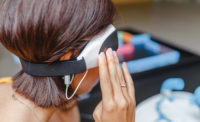Rethinking Medical Device Adhesives: More than a Sticky Afterthought
Choosing the right adhesive early can actively contribute to building better medical devices.

Medical device design engineers hold in their hands the power to help transform people’s health. They have the ever-important job of designing medical devices that help people monitor, track, and adjust their health for the better. However, some design engineers may be making a mistake that can affect how an entire medical device functions: they could be reducing adhesive selection to an afterthought. This critical decision is too often left until device design is almost complete.
It is not the engineers’ fault, however, because there is often a misconception surrounding adhesives. Adhesives are largely seen as a tactical, simple material. They do not compute, store, or display data; nor do they power the device. They are purely used to stick one thing to another thing.
On the surface, these assumptions are correct. However, if time is taken to learn more, engineers will find that choosing the right adhesive early can actively contribute to building a better device. In fact, choosing poorly can even be detrimental. We need to avoid thinking of adhesives as an inconsequential part of the device stack and start seeing them for what they are—an intimate connection system that is essential for the device to function properly.
Data Transfer
In most devices, adhesives play two roles: adhere the device’s components together; and stick the device to the user’s body. In either role, the ultimate goal is to hold the device together for its intended duration so it can collect and transfer data.
Adhesives must accommodate unique sets of challenges to be successful. When sticking the device to the user’s body, an adhesive must still let the skin breathe, move and flex, expel moisture, and grow hair, all as it normally would. Skin is integral in protecting against infection and regulating body temperature. When a device inhibits its ability to function, the skin may naturally reject or otherwise react to the device or potentially become irritated or otherwise damaged, limiting the device’s ability to collect reliable data.
When adhering components together, adhesives must do so without interacting with other materials or impeding the device’s ability to extract data from the body. The adhesive must also be able to withstand the manufacturing speed and friction, as well as the environmental conditions in which the device will be made, stored, and sold.
Because so much is required of them, adhesives need to be designed-in as part of the larger system. When it comes to deciding which one is the best choice, form should follow function. Think about what you want your device to achieve, as opposed to what characteristics your adhesive needs to possess. Broadening your lens in this way will help your materials partner identify options that serve the entire device instead of just a specific function.

Properly selected medical device adhesives help healthcare providers provide counsel and treat conditions.
Healthcare Cost Savings
An important discussion within American healthcare over the last several years has been about the cost involved after someone becomes sick and has to manage a chronic illness vs. the cost of preventative care. The imbalance feeds a system that treats the sick rather than keeps people healthy.
You might be wondering what this has to do with adhesives. Though seemingly small and thin, adhesives play an influential role in how medical devices function. When an adhesive is incapable of performing as it should, the domino effect goes beyond a single layer malfunctioning in the device.
The wrong adhesive could mean the device is not able to collect data as intended. As a result, the person using the device can no longer track their health status and adjust behavior accordingly. In addition, their healthcare provider loses the window into their patient’s life that allows them to provide counsel and treat conditions. From there, the person may need to seek additional medical care or, worse, go without support and potentially experience worsening health as a result.
When adhesives perform as needed, however, they can help enable longer wear times for devices while maintaining skin health. People can track their health from the comfort of their homes, therapy can be extended, and the body’s largest organ can function without being jeopardized by something meant to help it.
User-Requested Designs
As medical devices continue to go beyond the disease-treatment space and into health and wellness monitoring functionalities, the requirements that make up a successful device also need to expand. Wear time, accuracy, and reliability are still of utmost importance.
How well a device fits into the user’s everyday life—from comfort and device size to shape and usability—becomes the differentiating factor between one device and its competition. For example, because adhesives take up less space than mechanical fasteners, they offer more flexibility in slimming down a device’s profile and weight.
It is important to design a medical device that can seamlessly integrate into a user’s lifestyle without compromising their independence or the quality of data. This sentiment is not necessarily new. Many medical device manufacturers have already been striving to meet this success indicator. As expectations of technology, data, and the experience interacting with both evolve, manufacturers need to get on board or be left behind.
Making Connections
Think about a friend or loved one with a chronic condition or one who is working to better their health. Can their physician monitor their health in real time? Does your friend rely on internal data to make medical decisions? Would both help improve the person’s overall health?
The power to create better, smarter medical devices that keep people healthy is in our hands. We need to start seeing adhesives as the intimate connection between device and user, not as a simple material that is added to the device. Doing so will empower medical devices to do all they can to help improve our lives.
For more information, visit www.3m.com/medtech.
Note: Images courtesy of 3M.
Looking for a reprint of this article?
From high-res PDFs to custom plaques, order your copy today!








